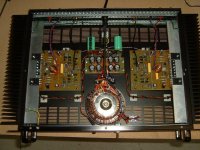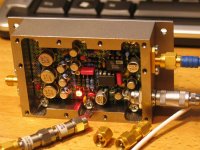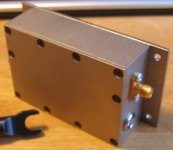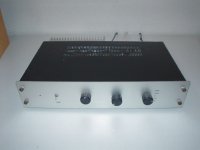Hi Fotios - happy new year.
Resistors are Vishay and Dale
Relays are Panasonic AG types for small signal applications
I've used Panasonic caps for all electrolytics, Wima for decoupling. Sliver Mica's are indeed Cornell-Dubilier.
for the Phono-amp, I still have to get some caps (Panasonic also).
PCB is from PCB Cart (China) - very good service and good price.
Box is from Modushop, Italy (Knobs also).
Resistors are Vishay and Dale
Relays are Panasonic AG types for small signal applications
I've used Panasonic caps for all electrolytics, Wima for decoupling. Sliver Mica's are indeed Cornell-Dubilier.
for the Phono-amp, I still have to get some caps (Panasonic also).
PCB is from PCB Cart (China) - very good service and good price.
Box is from Modushop, Italy (Knobs also).
Attachments
Thanks Bonsai
I have to say only one thing more. These Modu cases with their 10mm thick front panel, offer amazing flexibility for mounting the control and indication gear. You can open on it blind threads very easy so you can obtain a clear front panel view.
Bonsai, you are a big craftsman... included your knoweledge in electronics design.
Regs
Fotios
I have to say only one thing more. These Modu cases with their 10mm thick front panel, offer amazing flexibility for mounting the control and indication gear. You can open on it blind threads very easy so you can obtain a clear front panel view.
Bonsai, you are a big craftsman... included your knoweledge in electronics design.
Regs
Fotios
Bonsai said:Thank you Fotios!
Hi again Bonsai
By looking the front panel and because it is white, i thought why you don't place signs and labels on each control as well your logo. It is very easy with the laser transfer method. With a good quality photo paper for inkjets, you can do this. Many people here make use of this trick. The signs are very durable and the removing is easy with any paint solvent without damage of anodising.
Regs
Fotios
After 6 years of home renos, demolition and building I’ve finally got my workshops in order and am able to start building up my numerous designs in final form, taking them from the ugly prototype / electrocution and fire hazard stage and into neatly cased assemblies.
I’m starting with the little amps first. Here is how far I got today with my 12W class A amp. Should get this one ticked off the list tomorrow, then I’ll move onto my 40W class A amp 😀
Cheers,
Glen
I’m starting with the little amps first. Here is how far I got today with my 12W class A amp. Should get this one ticked off the list tomorrow, then I’ll move onto my 40W class A amp 😀
Cheers,
Glen
Attachments
Fotios,
both front plates (pre and power amp) will be replaced (probably February or March) with new ones fully engraved from Front Panel Express. I will try the irn on trick for th e rear panels. I will start on my 'high-end' pre-amp in th e nex t month as well.
both front plates (pre and power amp) will be replaced (probably February or March) with new ones fully engraved from Front Panel Express. I will try the irn on trick for th e rear panels. I will start on my 'high-end' pre-amp in th e nex t month as well.
Solid looking little amp Glen. We are looking forward to seeing some of your bigger stuff as well.
🙂
🙂
FastEddy said:Glen: Where did you get that classy chassis??
Good layout, execution = 😀
It's just a 2U rack case with a pair of 300mm Conrad heatsinks screwed to the sides.
I got both from Altronics here in Oz:
http://www.altronics.com.au/index.asp?area=item&id=H0542
http://www.altronics.com.au/index.asp?area=item&id=H5038
Bonsai said:Solid looking little amp Glen. We are looking forward to seeing some of your bigger stuff as well.
🙂
Thanks Bonsai. You're preamp looks pretty flash too.
Cheers,
Glen
K12A finito.
Not to get too technical in picture thread, but the vertical board is a little discrete regulator providing +/-25V for the input stage and VAS circuitry.
As a general safety hint, anyone building mains powered equipment into rack cases such as these must wire each panel to mains earth individually, as the black passivated assembly screws and power coating results in the panels all being electrically isolated from each other.
Cheers,
Glen
Not to get too technical in picture thread, but the vertical board is a little discrete regulator providing +/-25V for the input stage and VAS circuitry.
As a general safety hint, anyone building mains powered equipment into rack cases such as these must wire each panel to mains earth individually, as the black passivated assembly screws and power coating results in the panels all being electrically isolated from each other.
Cheers,
Glen
Attachments
low noise preamp
Quickly built over the holiday season from things that happened
to be here:
600 pV/sqrt(Hz) noise density, flicker corner in the very low Hz.
1 MHz flat bandwidth @ 60 dB gain
300 KHz flat bandwidth @ 80 dB gain
Lower frequency corner is DC if offset servo is defeated, <1 Hz otherwise.
It's fun if your scope shows 200 nV/div, but that makes sense only
with an external lowpass because of noise bandwidth.
Circuit is built on Vero powerplane board. This has a ground plane
between the predrilled plated-tru pads.
Just scratch away the lacquer and apply a little more tin
to have a near perfect ground connection.
regards, Gerhard
Quickly built over the holiday season from things that happened
to be here:
600 pV/sqrt(Hz) noise density, flicker corner in the very low Hz.
1 MHz flat bandwidth @ 60 dB gain
300 KHz flat bandwidth @ 80 dB gain
Lower frequency corner is DC if offset servo is defeated, <1 Hz otherwise.
It's fun if your scope shows 200 nV/div, but that makes sense only
with an external lowpass because of noise bandwidth.
Circuit is built on Vero powerplane board. This has a ground plane
between the predrilled plated-tru pads.
Just scratch away the lacquer and apply a little more tin
to have a near perfect ground connection.
regards, Gerhard
Attachments
Bonsai said:What is that thing? A phono amp?
two of these amplifiers could be used as a moving coil preamp
(probably with reduced gain ), but I'll use it in front of the
FFT analyzer to measure noise in voltage references
or phase noise in oscillators.
Re: low noise preamp
Very nice.
It seem like you have some knowledge in vhf and uhf design.
Stinius
gerhard said:Quickly built over the holiday season from things that happened
to be here:
600 pV/sqrt(Hz) noise density, flicker corner in the very low Hz.
1 MHz flat bandwidth @ 60 dB gain
300 KHz flat bandwidth @ 80 dB gain
Lower frequency corner is DC if offset servo is defeated, <1 Hz otherwise.
It's fun if your scope shows 200 nV/div, but that makes sense only
with an external lowpass because of noise bandwidth.
Circuit is built on Vero powerplane board. This has a ground plane
between the predrilled plated-tru pads.
Just scratch away the lacquer and apply a little more tin
to have a near perfect ground connection.
regards, Gerhard
Very nice.
It seem like you have some knowledge in vhf and uhf design.
Stinius
Re: Re: low noise preamp
Correction, it seem that you know a lot about HF engineering as well as LF.
Very nice pictures
Regards
Stinius
stinius said:
Very nice.
It seem like you have some knowledge in vhf and uhf design.
Stinius
Correction, it seem that you know a lot about HF engineering as well as LF.
Very nice pictures
Regards
Stinius
Bonsai,
Nice job on the preamp! Is the blue finned part shown in
post #656 a bridge rectifier? Who makes it?
Thanks.
Nice job on the preamp! Is the blue finned part shown in
post #656 a bridge rectifier? Who makes it?
Thanks.
Hello fritz39.
The blue finned thing on the right is the Amveco transformer - you can get it from digi-key.
The blue finned thing on the right is the Amveco transformer - you can get it from digi-key.
- Home
- Amplifiers
- Solid State
- Post your Solid State pics here





